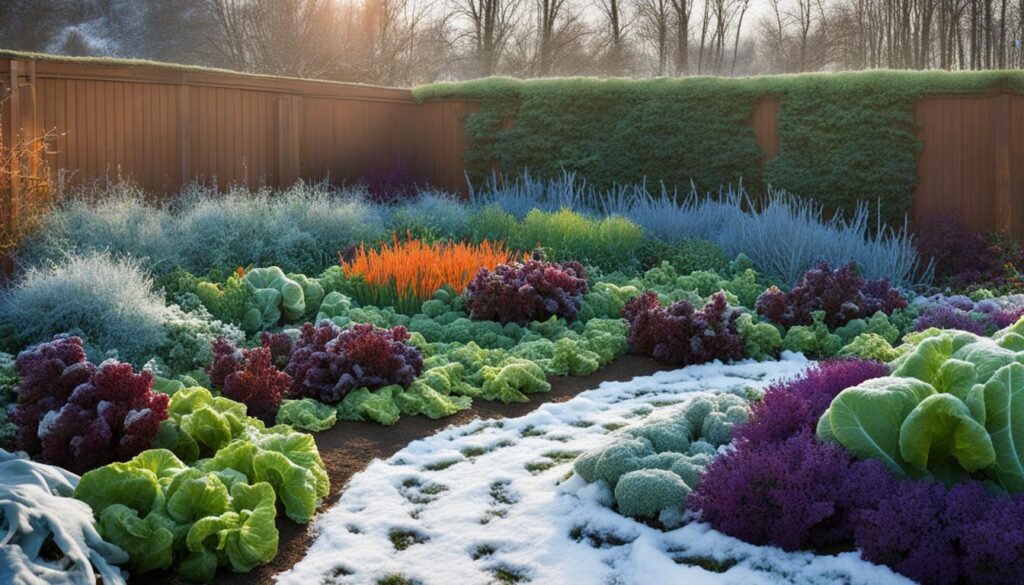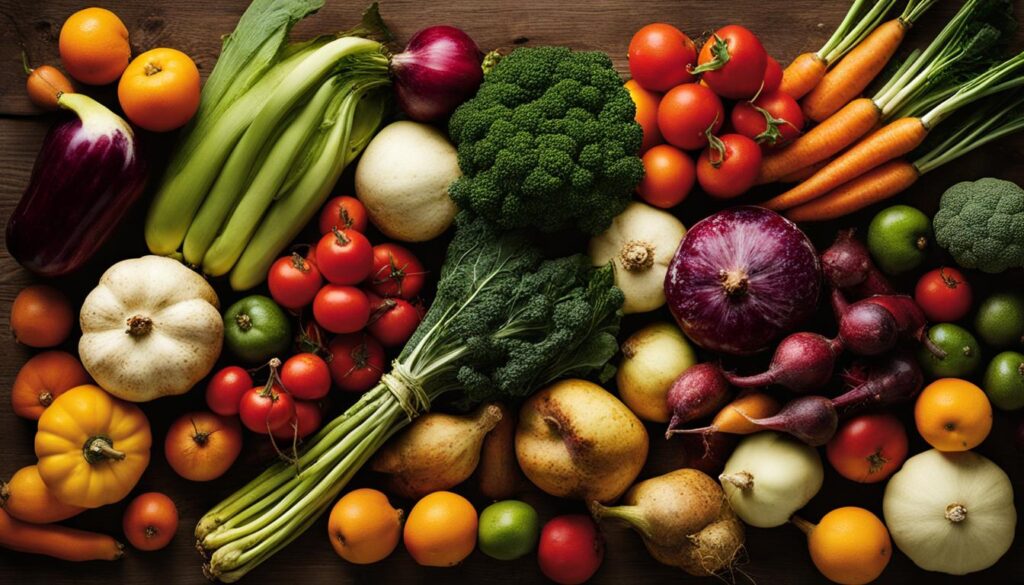Year-round crop production is a realistic ambition for gardeners and farmers in the United States. With the right techniques and planning, you can extend your growing season, overwinter vegetables, close seasonal gaps, make an early start, spread your harvests, and plant in succession. By doing so, you can enjoy a continuous supply of fresh produce throughout the year.
Key Takeaways:
- Year-round crop production is achievable through proper planning and strategic planting.
- Extend your growing season by using row covers, low tunnels, and cold frames to protect crops from frost.
- Overwinter vegetables in a cold frame or greenhouse to ensure continuous growth during the winter months.
- Close the “hungry gap” by strategically planning late summer sowings and utilizing winter-stored produce.
- Make an early start with sowing under cover and pre-warming the soil for tender crops.
Extending the Growing Season
One of the key strategies for maximizing year-round crop production is extending the growing season. By doing so, you can protect your crops from frost and create a warm microclimate that promotes continued growth.
One effective method for extending the growing season is using row covers, low tunnels, and cold frames. These protective structures provide a barrier against frost, shielding tender plants like cucumbers, peppers, and tomatoes. By using these covers, you can enjoy a longer harvest well into the fall.
Another technique to consider is utilizing sun-facing walls. These walls can create a warm microclimate that helps extend the growing period of summer favorites. By harnessing the natural heat from the sun and redirecting it towards your crops, you can enjoy an extended growing season and continue harvesting fresh produce.
By implementing these strategies, you can ensure that your crops have a longer growing period, allowing for a more abundant harvest throughout the year. Protecting your crops from frost and creating a warm microclimate are essential steps in maximizing your year-round crop production.
Key Points:
- Use row covers, low tunnels, and cold frames to protect crops from frost
- Utilize sun-facing walls to create a warm microclimate
- Extend the growing season to enjoy a longer harvest
Overwintering Vegetables
Overwintering vegetables are a key component of year-round crop production. By providing protection from harsh winter conditions, you can continue to enjoy a bountiful harvest even in colder months.
One effective method for overwintering vegetables is by using a cold frame or greenhouse. These structures create a favorable microclimate that shields your crops from frost and extreme temperatures. The controlled environment helps maintain optimal growing conditions, extending the lifespan of hardy crops and ensuring a continuous supply of fresh produce.
Some popular overwinter vegetables include salad greens such as mizuna, tatsoi, and winter lettuce. These leafy greens thrive in cooler temperatures and can provide a nutritious addition to your winter meals. Root vegetables like carrots, parsnips, beets, and leeks also fare well when overwintered, and their flavors are enhanced by the colder weather.
Remember to provide adequate spacing between plants and harvest little by little to ensure continuous growth. By incorporating overwintering techniques into your crop production strategy, you can enjoy a diverse selection of produce throughout the year, even when the weather outside is less than ideal.
Closing the ‘Hungry Gap’
Plan your crops strategically to bridge the ‘hungry gap’ and ensure a continuous supply of fresh produce. Late summer sowing is key to overcoming this period when the previous season’s crops are finished, but the current season’s crops are not yet ready for harvesting.
By planting vegetables like broccoli, cabbage, and leeks in late summer, you can fill the gap and join the last of the winter-stored produce, such as squashes. These crops will mature during the lean time, providing you with a bountiful harvest.
Additionally, consider incorporating perennial crops like asparagus and rhubarb into your garden. These plants offer reliable yields during the ‘hungry gap’ and can be enjoyed when other crops are scarce.
Benefits of Closing the ‘Hungry Gap’
- Continual fresh produce: By carefully planning your crops, you ensure a steady supply of vegetables even during the transition between seasons.
- Maximized harvests: Closing the ‘hungry gap’ allows you to maximize the productivity of your garden or farm throughout the year, providing you with a diverse selection of fresh produce.
- Reduced dependency on external sources: By growing your own vegetables and closing the ‘hungry gap,’ you decrease reliance on store-bought produce, saving money and reducing your carbon footprint.
With thoughtful planning and late summer sowings, you can successfully close the ‘hungry gap’ and ensure a continuous supply of fresh vegetables year-round. Incorporate a variety of crops and take advantage of winter-stored produce to keep your garden thriving even during the lean times.
Making an Early Start
When it comes to maximizing your year-round crop production, making an early start is a key strategy. By sowing under cover and pre-warming the soil, you can give your tender crops a head start and extend their growing period. Utilizing cold frames, tunnels, greenhouses, or even sunny windowsills can provide the necessary protection for your seedlings.
Starting your seedlings indoors with the help of grow lights can give them the extra boost they need to establish healthy roots and grow quickly. This method is especially useful for crops like tomatoes and eggplants that require a longer establishment period. By getting an early start, you can enjoy your bountiful harvest sooner.
“By sowing under cover and pre-warming the soil, you can give your tender crops a head start and extend their growing period.”– Gardening expert
Pre-warming the soil is another effective technique for an early start. By covering the soil with clear plastic or using mulch to trap heat, you can raise the temperature and create a favorable environment for your crops. This method is particularly beneficial for warm-season vegetables that thrive in higher soil temperatures.
Making an early start not only gives you a jump on the growing season but also allows you to enjoy your favorite crops for a longer period. By taking advantage of these techniques, you can ensure a successful and fruitful year-round harvest.
Spreading Your Harvests
One of the keys to enjoying a continuous supply of fresh produce throughout the growing season is to spread your harvests. By sowing quick-maturing varieties little and often, you can maximize the duration of each vegetable’s harvest period and enjoy each one for a longer time. This approach ensures that you don’t have an overwhelming abundance of crops all at once, but instead have a steady supply over an extended period.
To implement this strategy, consider selecting a variety of early, mid, and late-season crops. For example, you can plant early-season lettuce varieties in spring, followed by mid-season tomatoes and peppers, and then finish with late-season brassicas like broccoli or kale. By staggering the planting times and choosing crops with varying maturation periods, you can spread out your harvests and enjoy a diverse range of fresh vegetables throughout the season.
Additionally, it’s important to keep in mind the specific recommendations for each crop. Some vegetables, such as leafy greens and herbs, can be continuously harvested by cutting only the outer leaves or stems, allowing the interior to continue growing. This technique promotes further growth and prolongs the harvest period.
By adopting a strategy of spreading your harvests and planting quick-maturing varieties, you can ensure a steady supply of fresh produce, avoid waste, and make the most of your garden or farm throughout the entire growing season.
Benefits of Spreading Your Harvests:
- Maximizes the duration of each vegetable’s harvest period
- Provides a continuous supply of fresh produce
- Allows for a diverse range of vegetables throughout the season
- Reduces waste by avoiding an overwhelming abundance of crops at once
- Promotes further growth and prolonged harvest through selective harvesting
Planting in Succession
Planting in succession is a crucial technique for ensuring a steady supply of crops throughout the growing season. By planning and strategizing your planting schedule, you can avoid gaps in your harvests and enjoy a continuous abundance of autumn and winter maturing vegetables.
When implementing succession planting, it’s important to consider the layout of your fields. Having a well-thought-out field layout can optimize space and maximize efficiency. By grouping crops with similar growth rates and maturity times together, you can easily rotate plantings and make the most of your available land.
In addition to field layout, having a dedicated nursery area in a greenhouse or cold frame can greatly facilitate succession planting. This allows you to raise crops from seeds and transplant them when space becomes available in the field. It also provides a protected environment for seedlings, ensuring their healthy development before they are ready to be planted outdoors.
By employing succession planting techniques and optimizing your field layout, you can create a harmonious and productive growing system that keeps your harvests plentiful throughout the year.
Benefits of Succession Planting
- Continuous harvests: Succession planting ensures a steady supply of crops, eliminating periods of scarcity in your garden or farm.
- Maximized space utilization: By planning your plantings strategically, you can make the most efficient use of available land and optimize your yields.
- Extended season: Autumn and winter maturing vegetables can be enjoyed well into the colder months, providing fresh produce when other crops may not be available.
- Reduced risk of crop failure: By staggering your plantings, you minimize the chances of losing your entire harvest to pests, diseases, or unfavorable weather conditions.
Succession planting allows you to have a diversified and continuous supply of vegetables throughout the year. By carefully planning your plantings and optimizing your field layout, you can optimize space and extend your growing season. This ensures a bountiful harvest and a consistent supply of fresh produce for your kitchen or market. Don’t miss out on the benefits of succession planting – start incorporating this technique into your gardening or farming practices today!
Conclusion
Maximizing your harvests and planning for year-round crop production requires careful strategizing and consideration of various techniques. By implementing methods such as extending the growing season, overwintering vegetables, closing the hungry gap, making an early start, spreading harvests, and planting in succession, you can enjoy a continuous supply of fresh produce.
When extending the growing season, protect your crops from frost by utilizing row covers, low tunnels, and cold frames. These protective measures can help you continue harvesting crops like cucumbers, peppers, and tomatoes well into the fall. Additionally, creating a warm microclimate by utilizing sun-facing walls can extend the growing period for your summer favorites.
Overwintering vegetables play a crucial role in year-round crop production. By utilizing cold frames or greenhouses, you can successfully grow salad greens, leafy greens, and root vegetables during the winter months. Remember to provide adequate spacing and practice harvesting little by little to ensure continuous growth.
To close the hungry gap, strategically plan late summer sowings of vegetables like broccoli, cabbage, and leeks. These crops can bridge the gap between the previous season’s crops and the current season’s crops. Additionally, perennial crops like asparagus and rhubarb can be enjoyed during this lean time, providing a steady supply of produce.
Making an early start is essential for certain crops that require a longer establishment period. Sowing under cover using techniques such as cold frames, tunnels, greenhouses, or sunny windowsills can provide the necessary protection. Starting seedlings indoors with grow lights and pre-warming the soil can also accelerate the growth of tender crops like tomatoes and eggplants.
Spreading your harvests throughout the year involves sowing quick-maturing varieties little and often. By selecting a variety of early, mid, and late-season crops, you can maximize the duration of each vegetable’s harvest period. This means you can enjoy a continuous supply of carrots, strawberries, and other crops throughout the seasons.
Planting in succession is crucial to ensure a steady supply of crops. By planting new crops after the initial ones are finished, you can avoid gaps in your harvests. Consider autumn and winter-maturing vegetables, including those suitable for storage, and plan your field layout accordingly. Having a dedicated nursery area in a greenhouse or cold frame can also help raise crops from seeds and transplant them when space becomes available in the field.
With careful planning and strategic planting, you can maximize your harvests and enjoy a continuous supply of fresh produce throughout the entire year. Take into account regional climate conditions and select suitable crops for year-round farming. By implementing the techniques discussed, you can make the most of your garden or farm and achieve a successful year-round crop production.
How Do Year Round Crops Fit Into a Master Vegetable Garden Layout Plan?
When planning a master vegetable garden layout and spacing, incorporating year-round crops is essential for maximizing production. By strategically placing perennial vegetables like asparagus, rhubarb, and artichokes alongside annual vegetables, you can make efficient use of space and ensure a consistent harvest throughout the year.
FAQ
Is year-round crop production possible for gardeners and farmers?
Yes, with the right techniques and planning, year-round crop production is a realistic ambition.
Which states in the U.S. provide favorable climates for year-round farming?
Several states, such as Florida, California, Texas, Arizona, Georgia, Alabama, Louisiana, South Carolina, Mississippi, New Mexico, Hawaii, Washington, and Oregon, provide favorable climates and resources for year-round farming.
How can I extend the growing season and protect crops from frost?
Gardeners can use row covers, low tunnels, and cold frames to provide protection from frost and extend the growing season.
What are some examples of overwintering vegetables?
Examples of overwintering vegetables include salad greens like mizuna, tatsoi, and winter lettuce, as well as leafy greens such as chard and spinach. Root vegetables like carrots, parsnips, beets, and leeks also fare well with the protection of a cold frame or greenhouse.
What is the “hungry gap” and how can I close it?
The “hungry gap” refers to the period between the finish of the previous season’s crops and the readiness of the current season’s crops. Strategic planning, late summer sowings, and utilizing winter-stored produce can help bridge this gap.
How can I make an early start with my crops?
To achieve an early start, you can sow under cover using methods such as cold frames, tunnels, greenhouses, or sunny windowsills. Starting seedlings indoors with grow lights and pre-warming the soil can also accelerate the growth of tender crops.
How can I spread my harvests and enjoy each vegetable longer?
By selecting a variety of early, mid, and late-season crops and sowing quick-maturing varieties little and often, you can maximize the duration of each vegetable’s harvest period. This allows you to enjoy a continuous supply of crops.
What is succession planting and how can it help maintain a steady supply of crops?
Succession planting involves planting new crops after the first ones are done, ensuring a continuous harvest. Autumn and winter-maturing vegetables, including those suitable for storage, can be planted from midsummer onwards to fill the gaps. Having a dedicated nursery area in a greenhouse or cold frame can also help raise crops from seeds and transplant them when space becomes available in the field.
What is the key to year-round crop production?
The key to year-round crop production is careful planning and strategic planting. By considering regional climate conditions, utilizing protective structures, and selecting suitable crops, you can maximize your harvests and enjoy a continuous supply of fresh produce throughout the year.












